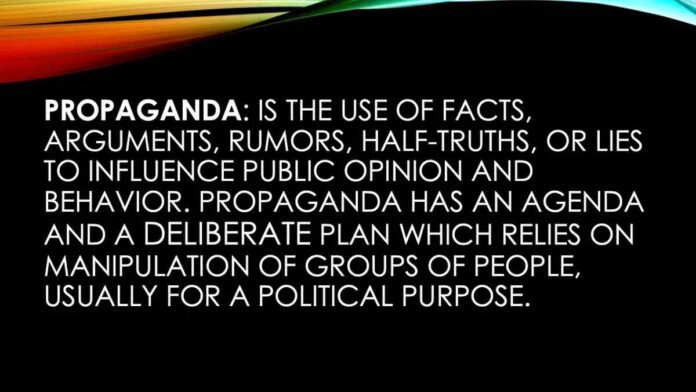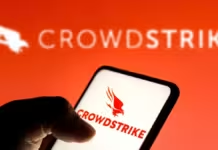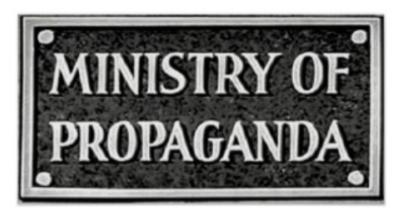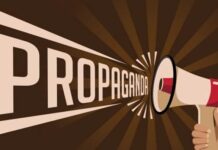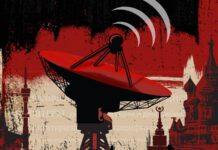Edward Bernays’ classic tome “Propaganda,” published in 1928, was an attempt to both alert the public to the power of propaganda while also allaying the public’s fear of it. The overall messaging of the book now seems so naïve. One of the core themes and underlying beliefs of the book is that there are elements in society which are not corruptible.
As an example, the book ends with the thesis that newspapers are the arbiter of news, thus the editors, writers and owners are the gatekeepers ensuring the public of a fair rendition of both sides of any issue. The idea of newspapers spreading propaganda was virtually unthinkable.

This may have been how journalism was perceived in the past, but that is no longer the case (if it ever was). The idea that the government or a political party might buy up enough advertising space or provide other incentives so that a newspaper editor would think twice about running a story contrary to the government’s position was not even a consideration. The view that newspaper writers, editors or owners couldn’t be bribed or converted to one cause or another seems to not enter the author’s mindscape. The idea that the newspapers of today would become advocacy conduits for one set of beliefs held by the government over another set of beliefs seemed far-fetched in 1928. Now it seems unthinkable that it would be any other way.

Propaganda is a form of public opinion manipulation involving the creation of a specific narrative that aligns with a political agenda. It uses techniques like nudging, repetition, emotional appeals, selective information, and hypnotic language patterns to influence the subconscious mind, thereby bypassing critical thinking and shaping beliefs and values.
Propaganda is made up of truth, almost truths, half-truths, truth out of context as well as false truths. Its purpose is not necessarily evil, but it is always meant to manipulate the mental state of those receiving it. This is an important concept that this classic book makes over and over again. Governments and organizations use propaganda for good and evil.
The distribution of “truthful” or “untruthful” information which causes the recipient to become wary or skeptical of the government and its intentions is defined by the US Department of Homeland Security (DHS) as malinformation. Information which may or may not be truthful but differs from the US Government’s approved narrative at that point in time is defined by DHS as misinformation. Either DHS-defined malinformation or misinformation which is being distributed for a political purpose is defined as disinformation. Under the Biden administration, DHS defines the spreading of mis- dis- or malinformation as domestic terrorism, which then technically allows various laws, policies and US government programmatic infrastructure to “counter” such information and those who distribute it to be deployed in response.
In general, propaganda is classified by colors: White, Gray and Black Propaganda.
White Propaganda:
- White propaganda is a type of propaganda where the producer of the material is clearly marked and indicated, and the purpose of the information is transparent.
- White Propaganda is commonly known as marketing and public relations.
- White Propaganda involves communicating a message from a known source to a recipient (typically the public or some targeted sub-audience).
- White Propaganda is mainly based on fact, although the whole truth is often not told.
Gray Propaganda:
- Gray Propaganda is communication of a false narrative or story from an unattributed or hidden source.
- The messenger may be known, but the true source of the message is not.
- By avoiding source attribution, the viewer becomes unable to determine the creator or motives behind the message. This is common practice in modern corporate media, in which unattributed sources are often cited.
- An example of gray propaganda would be placing news stories in news outlets instead of buying ads to directly appeal to the intended audience. This is also common practice, extending to “ghost writing” of entire articles by corporations or advocacy groups which are then published as if originating from independent news outlet analysis and writing.
- When using gray propaganda, a message or false narrative coming through the news media appears to be neutral, thus believable, whereas the direct appeal from someone who is clearly an opponent of the target (person or organization) or advocate of the promoted message would be unbelievable.
- Astroturfing, the use of fake organized “grassroots” movements to spread a message or false narrative is an example of gray propaganda.
- Operation Mockingbird, the large-scale program of the United States Central Intelligence Agency (CIA) that began in the early years of the Cold War and manipulated domestic American news media organizations for propaganda purposes, often employed Gray Propaganda.
Black Propaganda:
- Black propaganda is designed to create the impression that it was created by those it is intended to discredit.
- Black Propaganda is typically used to vilify or embarrass an opponent or enemy through misrepresentation.
- The major characteristic of black propaganda, when effective, is that the recipient (audience) is not aware that someone is influencing them, and therefore does not feel pushed in a certain direction.
- Black propaganda purports to emanate from a source other than the true source. This is the type of propaganda most often associated with covert psychological operations.
- Sometimes the source is concealed or credited to a false authority and used to spread lies, fabrications, and deceptions.
- Black propaganda is the “Big Lie,” including all types of creative deceit.
- Black propaganda relies on the willingness of the receiver to accept the credibility of the source. If the creators or senders of the black propaganda message do not adequately understand their intended audience, the message may be misunderstood, seem suspicious, or fail altogether.
Examples of Black Propaganda:
- Declassified documents have revealed that the British government ran a secret “black propaganda” campaign for decades, targeting Africa, the Middle East and parts of Asia with leaflets and reports from fake sources aimed at destabilizing cold war enemies by encouraging racial tensions, sowing chaos, inciting violence and reinforcing anti-communist ideas.
- The US DoD Office of Strategic Influence (OSI) (now renamed and restructured as the “Office of Information Activities”) was specifically designed to propagate black propaganda.
- The Office of Information Activities (OIA) currently resides within the Office of the Assistant Secretary of Defense for Special Operations and Low Intensity Conflict with responsibility for policy oversight of military psychological operations activities.
- Following 9-11, the US DoD organized and implemented the Office of Strategic Influence (OSI), which maintained a mission described by The New York Times as “circulating classified proposals calling for aggressive campaigns that use[d] not only the foreign media and the Internet, but also covert operations.”
- At the time, Pentagon officials said that the OSI was to pursue “a broad mission ranging from ‘black’ campaigns that use disinformation and other covert activities to ‘white’ public affairs that rely on truthful news releases.”Therefore, OSI’s operations were intended to include black propaganda activities.
- OSI’s operations included contacting and emailing media, journalists, and community leaders with information that would counter foreign governments and organizations that are hostile to the United States. In doing so, the emails would be masked by using addresses ending with .com as opposed to using the standard Pentagon address of .mil, and hide any involvement of the US government and the Pentagon.
With the advent of computational technology, particularly the internet, the ability of many different factions to use propaganda has grown exponentially.
Computational propaganda can be described as an “emergent form of political manipulation that occurs over the Internet” (Woolley and Howard, Computational Propaganda. Political Parties, Politicians, and Political Manipulation on Social Media, 2018, p. 3). Computational algorithmic propaganda is used in social media — on blogs, forums and other websites that involve participation and discussion. This type of propaganda is often executed through data mining and algorithmic bots, which are usually created and controlled by advanced technologies such as AI and machine learning. By exploiting these tools, computational propaganda can pollute information and rapidly spread false news around the internet (Woolley and Howard, 2018).
The European parliament has defined computational propaganda as “the use of algorithms, automation, and human curation to purposefully distribute misleading information over social media networks.”
One can easily detect a major issue with this definition. Remember, the classic definition of propaganda is that it is composed of truths and untruths meant to coerce and manipulate for good or evil. However, the working definition of “computational propaganda” is that it is only comprised of “misleading” information meant for nefarious (evil) purposes. Does this mean that if a government uses computational algorithms to manipulate via truthful information then this is not computational propaganda?
By using this narrow definition, which has spread throughout academia and the internet, the European Parliament has defined propaganda to include only malicious “misinformation.” Hence, computational methods to spread good information would not be included in their definition of computational propaganda. Was this an intentional oversight? Most likely not.
Truth be told, it isn’t just “bad actors” who are using computational propaganda. Examples abound of how these technologies are being discussed and have been used across the world by governments to induce people to eat better, stop smoking or even behave in public spaces. This is generally referred to as “Nudge” technologies.
The problem is that, historically, those who employ propaganda will use whatever means are necessary to achieve their ends. Even when propaganda is in the service of doing good and is backed up by experts in the field, propaganda aims to control our thoughts and behaviors. The propagandist measures success by “effectiveness.” Propagandists will use whatever tools they are allowed to use to achieve those ends. Currently, there are no government regulations on just how far they are allowed to go. In fact, it is rarely acknowledged that these tools are even being used.
The tools available to modern propagandists have become increasingly sophisticated. Not only are we being subjected to data mining of the personal information which is freely available via the web to use against us, but these data are being combined with behavioral tools such as nudging, neuro-linguistic programming, hypnosis, visualization, and repetitive imagery and messaging, which are often employed through the use of bots and trolls.
Here is a safety tip: never participate in free, online questionnaires or games. The organizations that create these activities are selling your answers and your email or facebook address/personal information to interested third parties. This is one method of data mining that we should all be familiar with.
Over the last three years of the Covid crisis, propaganda methods based on advanced applied psychology have been developed and successfully deployed to coerce people to take experimental vaccine products, to wear paper masks that are not effective in preventing viral infection or transmission, and to quarantine or “lock down.” We have all lived through the effects of this massive propaganda campaign, the likes of which the world has never seen before.
Psyops: When propaganda techniques are used by the military, intelligence agencies or the police, it is referred to as Psyops. Psyops can be used by governments against a foreign population (PsyWar) or against the citizens of a government (domestically).
There is a misconception that the US Government does not conduct propaganda on its domestic population. This may have once been the case, but no longer. According to the US Department of Defense “Psychological Operations Manual” of 2010, in the case of domestic crisis management the DoD can become involved in Psyops operations against civilian citizens during times of crisis management. The manual states:
“When authorized, PSYOP forces may be used domestically to assist lead federal agencies during disaster relief and crisis management by informing the domestic population.”
Although many believed that the Smith-Mundt Act of 1948 banned the use of propaganda by the US government, nothing is further from the truth. The Smith-Mundt Act only applied to specific media outlets developed by the US Government for foreign markets, and only to the US State Department and to the relatively obscure Broadcasting Board of Governors (BBG). Furthermore, most of the prior restrictions placed by that act were repealed or amended in 2013. There is nothing that stops the US Government (including CIA and DoD) from propagandizing the American people. Our government, media, universities, and medical establishments are just a few of the domestic organizations that routinely use propaganda.
From 1975 to 1976, a wide range of CIA operations (including CIA ties with journalists) were examined in a series of Congressional investigations (the “Church Committee”). The most extensive discussion of CIA relations with news media from these investigations is in the Church Committee’s final report, published in April 1976. The report covered CIA ties with both foreign and domestic news media.
For foreign news media, the report concluded that:
The CIA currently maintains a network of several hundred foreign individuals around the world who provide intelligence for the CIA and at times attempt to influence opinion through the use of covert propaganda. These individuals provide the CIA with direct access to a large number of newspapers and periodicals, scores of press services and news agencies, radio and television stations, commercial book publishers, and other foreign media outlets.
For domestic media, the report states:
Approximately 50 of the [Agency] assets are individual American journalists or employees of U.S. media organizations. Of these, fewer than half are “accredited” by U.S. media organizations … The remaining individuals are non-accredited freelance contributors and media representatives abroad … More than a dozen United States news organizations and commercial publishing houses formerly provided cover for CIA agents abroad. A few of these organizations were unaware that they provided this cover.
Journalist Carl Bernstein, writing in an October 1977 article in the magazine Rolling Stone, said that the Church Committee report covered up CIA relations with news media, and named a number of journalists and organizations who CIA officers he interviewed said worked with the CIA. A copy of that article, titled “THE CIA AND THE MEDIA: How Americas Most Powerful News Media Worked Hand in Glove with the Central Intelligence Agency and Why the Church Committee Covered It Up” can be found here via the wayback machine.
Many believe that the CIA is prohibited from deploying modern propaganda and surveillance technologies on US Citizens, but that is not the case. In prior years, there have been various directives to this effect, for example:
According to the final Church Committee report, former CIA director William Colby told the committee that in 1973 he had issued instructions that “As a general policy, the Agency will not make any clandestine use of staff employees of U.S. publications which have a substantial impact or influence on public opinion.”
In response to the pressure from the emerging Church Committee findings, during February 1976 CIA Director George H. W. Bush announced an even more restrictive policy: “Effective immediately, CIA will not enter into any paid or contractual relationship with any full-time or part-time news correspondent accredited by any U.S. news service, newspaper, periodical, radio or television network or station.”
The final Church Committee report also stated that all CIA contacts with accredited journalists had been dropped at the time of publication. The Committee noted, however, that “accredited correspondent” meant the ban was limited to individuals “formally authorized by contract or issuance of press credentials to represent themselves as correspondents” and that non-contract workers who did not receive press credentials, such as stringers or freelancers, were not included.
Here is what congressional law (National Security Act of 1947) has to saw about domestic CIA activities (clause from SEC. 104A. (50 U.S.C. 3036):
RESPONSIBILITIES.—The Director of the Central Intelligence Agency shall—
(1) collect intelligence through human sources and by other appropriate means, except that the Director of the Central Intelligence Agency shall have no police, subpoena, or law enforcement powers or internal security functions;
(2) correlate and evaluate intelligence related to the national security and provide appropriate dissemination of such intelligence;
(3) provide overall direction for and coordination of the collection of national intelligence outside the United States through human sources by elements of the intelligence community authorized to undertake such collection and, in coordination with other departments, agencies, or elements of the United States Government which are authorized to undertake such collection, ensure that the most effective use is made of resources and that appropriate account is taken of the risks to the United States and those involved in such collection; and
(4) perform such other functions and duties related to intelligence affecting the national security as the President or the Director of National Intelligence may direct.
So while “internal security functions” were specifically prohibited by congressional legislation, congress provided the administrative state and the Executive (President) a back door to authorize the CIA do pretty much whatever they want it to do.
The American Civil Liberties Union followed up on the related issue of domestic CIA spying in a 2015 investigation and report titled “New Docs Raise Questions About CIA Spying Here at Home.” While links to many of the key cited documents have been deleted by today’s ACLU, they can be found at other sources such as the CIA’s Freedom of Information Act Electronic Reading Room. While the article is from 2015, subsequent executive actions and legislation only appear to have increased the authority of the intelligence community, including allowing the CIA to engage in domestic surveillance (directly and via the FBI), censorship and propaganda activities:
The current debate about government surveillance has largely overlooked the CIA, possibly because we know little about the agency’s activities within the United States. While the relevant legal authorities governing the CIA, including Executive Order 12333, set out the CIA’s mandate, they do so in broad terms. Beyond the generalities in EO 12333 and other laws, the public has had few opportunities to examine the rules governing the CIA’s activities.
The Most Important Surveillance Order We Know Almost Nothing About.
But we know more today than we did a few weeks ago. In response to a Freedom of Information Act lawsuit filed by the ACLU and Yale Law School’s Media Freedom and Information Access Clinic, the CIA has released a slew of documents concerning CIA surveillance under EO 12333. (The Justice Department has also recently released a set of documents related to the executive order.)
The national debate in the 1970s about the proper limits of U.S. government spying on its own citizens was, to a large extent, about the CIA. In the wake of the Watergate scandal and news stories about other illegal CIA activity, President Gerald Ford and Congress launched investigations into the full range of CIA misdeeds — from domestic spying programs and infiltration of leftist organizations to experimentation on non-consenting human subjects and attempts to assassinate foreign leaders.
Although the CIA’s legal authority to spy on Americans was very narrow, these investigative committees — chaired by Sen. Frank Church, Vice President Nelson Rockefeller, and Rep. Otis Pike — discovered that the CIA had engaged in a massive domestic spying project, “Operation CHAOS,” which targeted anti-war activists and political dissenters. The committee reports also revealed that, for more than 20 years, the CIA had indiscriminately intercepted and opened hundreds of thousands of Americans’ letters. In addition to documenting the intelligence agencies’ extensive violations of the law, the Church Committee concluded that the constitutional system of checks and balances “has not adequately controlled intelligence activities.”
The Church Committee’s conclusion — at core, an admonition — still resonates today. While the documents that the CIA has released are heavily redacted, raising more questions than they answer, they strongly suggest that the agency’s domestic activities are extensive.
Some highlights from the documents:
A key CIA regulation — titled “AR 2-2” — governs the conduct of the CIA’s activities, which include domestic intelligence collection.
AR 2-2, which has never been publicly released before, includes rules governing a wide range of activities, including surveillance of U.S. persons, human experimentation, contracts with academic institutions, relations with journalists and staff of U.S. news media, and relations with clergy and missionaries.
Several annexes to AR 2-2 contain the agency’s EO 12333 implementing procedures. For example, Annex A, “Guidance for CIA Activities Outside the United States,” sets forth the procedures that apply to CIA activity directed toward U.S. citizens and permanent residents who are abroad. Much of the relevant information is redacted. Annex F, “Procedures Governing Conduct and Coordination by CIA and DEA of Narcotics Activities Abroad,” is similarly redacted in key sections, including the section discussing the agencies’ “Specific Agreement Concerning Electronic Surveillance.”
The documents indicate that the CIA engages in a wide array of domestic activity, often in conjunction with the FBI.
Domestically, the CIA’s spying is governed by Annex B to AR 2-2, “Guidance for CIA Activities Within the United States.” This document explains:
Although EO 12333, AR 2-2, and Annex B prohibit the agency from engaging in electronic surveillance within the United States, the CIA can nevertheless ask the FBI to do its bidding:
Annex B and the CIA-FBI memorandum of understanding comport with past reporting that the Foreign Intelligence Surveillance Court authorized the FBI to work with the CIA to collect Americans’ financial records in bulk under Patriot Act Section 215.
In addition, Annex B explains that the CIA may “use a monitoring device within the United States under circumstances in which a warrant would not be required for law enforcement purposes if the CIA General Counsel concurs.”
But what qualifies as a “monitoring device”? And how exactly does monitoring differ from “electronic surveillance,” which the CIA is prohibited from doing domestically? We don’t know. In the newly released documents, the definition of “monitoring” (as distinct from “electronic surveillance”) is redacted.
The CIA also turned over several years’ worth of annual reports to Congress about the agency’s activities under EO 12333. These reports begin by discussing “Intelligence Activities Conducted by CIA Within the United States.” This header is followed by dozens of entirely redacted pages — once again suggesting that the agency is engaged in a significant amount of intelligence activity here at home.
The rules for the handling of Americans’ information are so complex that the CIA struggled to apply them properly.
A 2002 report by the CIA inspector general, “Intelligence Activity Assessment: Compliance with Executive Order 12333: The Use of [redacted] Collection [redacted] from 1995–2000,” observed “a general and widespread lack of understanding” within the CIA of the rules governing the retention and sharing of U.S. citizens’ and permanent residents’ information. In particular, the OIG found that few managers or other officers “could accurately state the appropriate procedures for retaining or disseminating U.S. person information,” and it concluded that these rules were “not being applied consistently” by the agency.
It benefits our government for people to believe that the US Government does not use propaganda against its own people, but nothing could be further from the truth. Furthermore, through the reciprocal spying and intelligence sharing terms and conditions of the Five Eyes Alliance (FVEY), any barriers to domestic spying and propaganda activities which one of the FVEY intelligence agencies encounters can be circumvented by working with another member.
By combining propaganda with techniques such as neuro-linguistic programming, hypnosis, bots, big data and controlled messaging, do “we the people” even have individual beliefs, or is everything we think manipulated? If that is the case, what does this mean for democracy?
When a government decides to wage PsyWar on its own citizens, then the fundamentals and concepts of free agency, sovereignty, voting integrity and representative democracy become irrelevant.
If we wish to remain independent thinkers and preserve our ability to learn, think, and debate issues, we must become warriors in the fight against propaganda.
A Real World Example of How the USG Propaganda System Works to Control
Johns Hopkins University, in conjunction with the Bill & Melinda Gates Foundation, the CDC, the UN, the World Health Organization (WHO), the World Economic Forum (WEF) and the CIA as well as world leaders and the mainstream media (MSM), held a series of Pandemic war games that occurred over the span of decades. The outcome of these exercises usually ended with the conclusion that there is a need to control populations in the case of a biothreat, during which behavioral modification and Psyops techniques would be used to enforce cooperation from the populace.
Even now, one can wander over to the Johns Hopkins Center for Health Security website and see that their current projects include an analysis of “anti-misinformation actions,” which they call the “Environment of Misinformation.” In March 2021, this center published a report entitled “National Priorities to Combat Misinformation and Disinformation for COVID-19 and Future Public Health Threats: A Call for a National Strategy.” In that report, they laid out some of the plans that governments across the world enacted during COVID-19:
“Ensure a whole-of-nation response through multisector and multiagency collaboration
- Ensure multisector collaboration in the development of a national strategy to combat public health misinformation through collective planning with social media, news media, government, national security officials, public health officials, scientists, the public, and others.
National Priorities to Combat Misinformation and Disinformation for COVID-19 and Future Public Health Threats: A Call for a National Strategy
- Increase coordination across the range of government stakeholders and conduct a cross-governmental analysis of efforts and responsibilities for managing health-related misinformation and disinformation in order to streamline and organize efforts.
Key US agencies include the Department of Defense, Department of Health and Human Services, and Department of Homeland Security as well as intelligence agencies such as the Federal Bureau of Investigation, the National Security Agency, and the Central Intelligence Agency.
- Encourage active, transparent, nonpartisan intervention from social media and news media companies to identify and remove, control the spread of, and curtail generators of false information.”
Note the first sentence advocates both a “whole-of-nation” and “multiagency” response and collaboration. That would include the Department of Defense as well as all branches of US intelligence. The next section specifically mentions the DoD and intelligence becoming more involved in combating misinformation and disinformation, not only for COVID-19 but for FUTURE public health threats.
The truth is that world leaders, governments, big media, big pharma, social media and tech giants are already busy planning out the next pandemic response. In fact, they are again weaponizing masks (and even banking!), and collecting up COVID case counts by more and more testing to ramp up the sales and marketing (e.g., propaganda) for new “booster” vaccines. This planning includes all of our intelligence agencies. In fact, on the Johns Hopkins Center for Health Security webpage titled “CURRENT PROJECTS, the Working Group on Readying Populations for COVID-19 Vaccine” lists two of its working group members from IQT (In-Q-Tel), which is the CIA’s private investment firm. This shows just how completely the CIA has captured the public health complex. This group’s mission includes “an agenda to guide the aggregation, generation, and translation of research about the social, behavioral, and communication challenges anticipated with COVID-19 vaccine.” This is evidence that the CIA, through IQT, is involved in working with non-profit agencies to create propaganda campaigns against the American people.
So, isn’t it time for those of us who believe there is a better way to live than to be controlled, to plan out responses and measures to combat all these draconian measures? To develop counter measures that could be utilized to a bio-threat that do not employ censorship, propaganda, mandates and behavioral modification techniques? You know, the old-fashioned way where the government relies on people to use their own critical thinking skills to assess what is best for themselves and their families after getting and examining all the relevant information available?
A collective group discussion concerning both how “we” were and are still being controlled, nudged, censored and lied to during the COVID-19 pandemic is in order. Because these efforts to control through behavioral modification and propaganda are only increasing throughout our digital world.
Truth and Propaganda:
Stella Morabito, author of the article “Truth or Propaganda” defines 10 questions one should ask to distinguish between truth and propaganda. A “yes” answer to any of these questions should make one wary of the source of the information.
1. Is your natural curiosity being suppressed? Whether the debate is about global warming or gender-neutral bathrooms, or anything else, if you have a nagging question or concern that is being cut off or shouted down, this is a clear sign you are being force-fed propaganda.
2. Are you being threatened with slurs or labels? Might you risk being called “bigot” or “hater” or “flat-earther” or worse if you simply express a personal preference? If so, you are in propaganda territory. Name-calling serves two purposes for propagandists: (1) it shuts down free inquiry and debate, and (2) it psychologically manipulates you through a fear of being “tarred-and-feathered.”
3. Do you feel you will be ostracized if you ask a question or express a politically incorrect view? The threat of ostracism is probably the oldest manipulative trick in aid of mind control. We are hardwired from infancy to avoid social isolation, which is why peer pressure is such a powerful force. This is also why solitary confinement is among the most dreaded of punishments. Political correctness depends on inciting the primal human fear of loneliness.
4. Do you notice a “herd effect” as people shift their opinions to adapt to a politically correct opinion? When others don’t feel comfortable having a real conversation with you, you’re living in a propaganda stew. Perhaps you see a classmate whom you were able to chat with earlier in the year but who has “evolved” with the program to the point that you can’t talk earnestly anymore. Maybe you notice how another classmate is excessively tentative in her speech and tone, a precautionary measure to avoid saying something “unacceptable.”
5. Are you being pigeonholed as a result of your question or opinion? Today’s propaganda often deconstructs your humanity by way of a scorecard that rates your level of privilege or oppression, based on skin color, class, family make-up, sexuality, “gender identity,” and a whole host of “intersectionality” components. Sadly, officials who promote “diversity and equality” are trained to ignore your humanity as an integrated individual so they can view you as a composite of bits and pieces of identity politics.
6. Do you sense that if you express ideas freely, you will be labeled a nutcase? Do you sense relational aggression at play? Gaslighting is a form of psychological abuse that is used by wife beaters as well as cult leaders. It is a natural byproduct of unchecked propaganda, too. The tactics of gaslighting are basically twofold. First, to get you to doubt your sanity, or at least get you to think you are utterly alone in your perceptions of the world. (Consider the constant use of the term phobia by today’s propagandists.) Second, gaslighters make a point of regulating and controlling the personal relationships of their victims so they feel even more isolated and dependent.
7. Will others be “triggered” by your opinion? If so, you are likely in a propaganda pocket: an “inquiry-free zone.” Emotional maturity has a lot to do with an individual’s ability to adapt. But propagandists see such maturity as a threat to their agendas. In fact, anything that enhances friendship or real understanding gets in the way of propaganda. Those who are “triggered” by a different opinion—who shut down emotionally by it—tend to be both the victims and the purveyors of propaganda.
8. Are you expected to trade in reality to prop up somebody’s illusion? One common example is the requirement that you adhere to pronoun protocols, even those that insist you refer to an individual with the plural pronouns they and them. This is a prime example of propaganda messing with your mind by messing with everybody’s language. No common language, no common reality, no communication. People end up even more isolated, unmoored in alternative realities that destabilize a sense of self.
9. Are you tempted to self-censor to avoid social punishment? Or are you tempted to falsify what you believe to gain social rewards? These two reactions build something called a “spiral of silence” that facilitates propaganda by creating the illusion of an opinion shift. It separates and isolates those who hold the politically incorrect opinion by inducing them—through fear of social rejection—to engage in self-censorship or to pretend to be on board with the program.
10. Do you sometimes feel like you’re stuck in a cult? Unchecked propaganda is cultlike in nature because it suppresses free inquiry and pushes utter conformity of thought. It also incorporates a lot of features of cults, including the use of deception, psychological manipulation, behavior modification, mind-hacking, divide-and-conquer tactics, social polarization, relational aggression, gaslighting, language control, and much more.”
Understanding the terrain of the PsyWar battlefield is a critical component in developing a game plan for resistance.
Robert Malone, M.D., M.S., is a biotechnology researcher who has gained an international following during the Covid pandemic by scientifically questioning the official narrative and making sense of its ensuing chaos. He pioneered mRNA vaccine technology in the late 1980s, and is the author of the book Lies My Gov’t Told Me, and the Better Future Coming. The above article appeared originally on Dr. Malone’s Substack and is reprinted here with permission.


